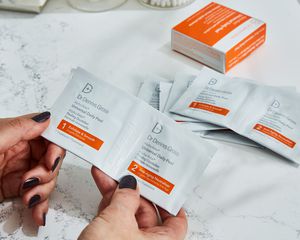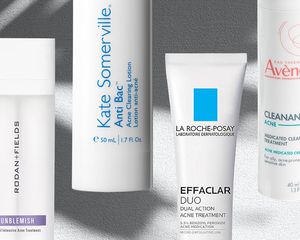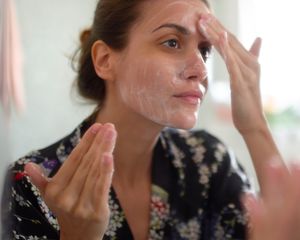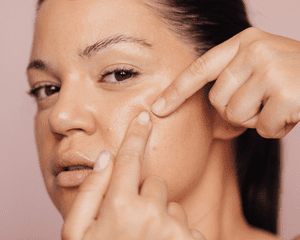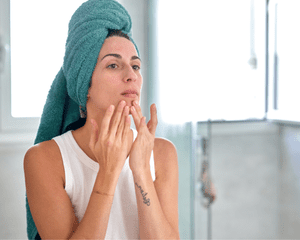:max_bytes(150000):strip_icc()/folliculitis-d534a9e801f44ab5ace7f63e9b577171.png)
Stocksy
There's quite the dictionary of breakouts that we have become all too familiar with. But on our quest for clear, healthy skin, sometimes we discover a blemish that we're just not sure of. If that's the case, you could be dealing with a folliculitis, a common skin disorder caused by the inflammation of hair follicles. "Think of it as acne that is on a skin site other than the face,” says dermatologist Dr. Alicia Zalka.
Fortunately, we spoke with Zalka and dermatologists Dr. Azadeh Shirazi and Dr. Morgan Rabach to find the best at-home and professional treatments for those small red or pus-filled bumps. Keep reading to see what dermatologists recommend to try to say goodbye to folliculitis.
Meet the Expert
- Alicia Zalka, MD, is a board-certified dermatologist and the founder of Surface Deep.
- Azadeh Shirazi, MD, is a board-certified dermatologist based in La Jolla, CA.
- Morgan Rabach, MD, is a board-certified dermatologist specializing in cosmetic and medical dermatology at LM Medical NYC.
What causes folliculitis?
Some of the most common causes are bacteria or yeast infections in the pores, sweat left on the skin for long periods of time, hormonal changes, overuse of oily products that block your pores, waxing and shaving, tight clothing, and even hot tub use. Some skin types are more likely to get an outbreak than others, but there are a number of factors that can cause folliculitis.
Use a Decongesting Cleanser
Before heading to a professional, stop by your local pharmacy for some at-home treatments. Zalka recommends using a cleanser that prevents pores from becoming clogged or inflamed. Neutrogena's Body Clear Body Wash comes highly recommended by Zalka, who says it "may help prevent oils, dead skin cells, and bacteria from infiltrating your pores." This can help prevent further folliculitis bumps.
Dig Deep With a Chemical Exfoliant
Sometimes it pays off to dig a little deeper. Exfoliating will help get rid of dead skin cells, which can help clear any ongoing outbreaks.
Many dermatologists recommend the Replenix Gly Sal 10/2 Cleanser ($30), which contains two exfoliating ingredients to cleanse the skin and remove buildup. Glycolic acid removes oil and unclogs pores while salicylic acid helps regulate oil production and encourage skin healing. Green tea extract calms and soothes skin to reduce redness and inflammation caused by blemishes.
Try Body Spray Treatments
If you’re on the go, there are also effective body sprays that allow easy application for difficult areas to reach that may reduce acne breakouts anywhere on the body.
Shirazi recommends her own GlySal Body Spray, formulated with 10 percent glycolic acid and 2 percent salicylic acid. "This is a leave-on treatment that promises not to bleach clothing (as can be the case with benzoyl peroxide treatments) and the formula dries extremely quickly," she says. To use, just spray onto affected areas and let the product dry before you put on your clothes.
Take a Break From Shaving and Waxing
If the problem you’re seeing persists, consider giving that area a break from shaving and/or waxing for a bit. Shaving and waxing can easily "open up" your breakout, exposing the whitehead and causing the spread of bacteria to other areas where you shave with the same razor head—thus leading to more breakouts.
Key Takeaways
- Folliculitis isn't a typical pimple — it's a common skin disorder caused by the inflammation of hair follicles. Zalka says to think of it as acne on the body, not the face.
- Folliculitis can be treated at-home or, if needed, with the help of a dermatologist. Treatments include topical creams, lifestyle changes, deep cleansers and when necessary, prescription medications.
Wear Loose-Fitting Clothing
It’s important to be mindful of your clothing choices when you’re dealing with a folliculitis outbreak. Try to avoid tight clothing for a while, which can cause friction or rubbing that further inflames your breakouts.
In this same vein, be sure to remove clothes directly after sweating or working out (and cleanse your skin right away). Sitting in the sweat can lead to further inflammation or clogging of the pores, so your best bet is to hop in the shower (or at least make an outfit change once you’re done working out).
Pro tip: Try using Zeasorb-AF powder before your workouts too to soak up sweat and moisture and prevent yeast overgrowth.
Try a Benzoyl Peroxide Wash
Benzoyl peroxide cleansers daily in the shower are very effective, as they kill pathogenic bacteria and remove dead skin cells.
For sensitive skin types, try reaching for the CeraVe Acne Foaming Cleanser. Or, if you’re looking for something to use on your torso or the rest of your body, you can use PanOxyl 10% BP Wash.
Use Acne Pads
Rabach says that acne pads containing salicylic acid, glycolic acid, or a mixture of both can also help. "Salicylic acid 2 percent can help dry up folliculitis," she says, adding that benzoyl peroxide can also help in drying the condition. We love First Aid Beauty FAB Pharma White Clay Acne Treatment Pads with 2 percent salicylic acid, but if you'd like to see if acne pads are a fit for you, Clearasil Rapid Rescue Deep Treatment Pads are much more wallet-friendly.
Consider Laser Hair Removal
Since the hair follicle is the root of the problem, and the follicles affected can be removed by laser in some circumstances, a dermatologist might recommend this option.
"Laser hair removal can thin the hair, reducing the incidence of folliculitis," says Rabach. Laser therapy destroys the hair follicles, preventing them from becoming inflamed or infected again. But in most cases, it takes several treatments to see results.
Try Hydrocortisone Cream
"If folliculitis happens post hair removal, over-the-counter hydrocortisone cream 1% can also soothe inflammation and redness," says Rabach. A favorite dermatologist brand, CeraVe's Hydrocortisone Anti-Itch Cream contains three essential ceramides, hyaluronic acid, and niacinamide to help hydrate skin and retain moisture despite being inflamed.
See a Dermatologist for Professional Treatments
If you’ve tried the at-home solutions and aren’t seeing the progress, it might be time to head to see a professional.
"If the over the counter medications do not work, if there is inflammation or pain that extends onto the skin, if the folliculitis last more than two weeks, or if the folliculitis is spreading, you should see a dermatologist," says Rabach.
The biggest warning signs are when pimples become painful, pus-filled, or if the condition spreads to other parts of your body. When evaluated medically, a dermatologist will likely ask about your medical background and potential causes of the folliculitis. They may prescribe a medicated cleanser and perhaps an oral medication to treat bacteria or yeast if either of these are considered to be the cause.
Use a Prescription Antibiotic
Specific types of folliculitis such as pseudomonas folliculitis may even require oral antibiotics, such as minocycline or doxycycline for a course until the folliculitis subsides, says Rabach. If over-the-counter topicals are ineffective, Rabach says that topical antibiotics like clindamycin lotion or gel may be of help, as well as sulfacetamide sulfur.

